7 - 12 July 2000
13 July 2000
In the reporting period, the Upper Composite has been mated with the Soyuz launcher's third stage. This was followed by the mating of the combined third stage and Upper Composite with the launcher's first and second stage. The fully integrated launcher was rolled out to the launch pad and successfully installed in upright position.Wednesday 12 July
Roll-out and installation onto pad
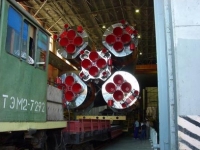 |
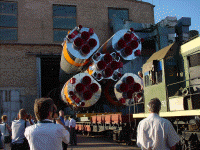 |
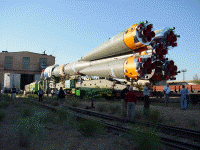 |
A large number of spectators, from the project team as well as from the Russian side, witnessed the vehicle's 30 minute transfer to the pad by train. Once it arrived at the pad, the Soyuz was erected on the pad from horizontal into vertical position, using the hydraulic erector (in no more than 7 minutes). The activity was followed by the anchoring of the rocket to the launch pad, release of the erector and aiming of the launch vehicle, i.e. a rotation around its vertical axis in order to achieve the exact azimuth needed for the launch.
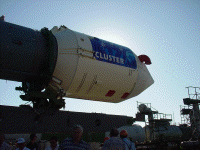 |
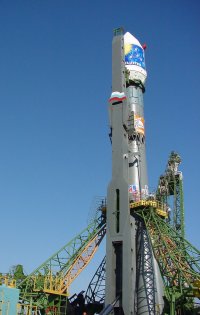 |
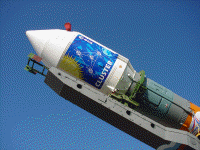 |
Several small activities on the pad then went on until around 10:45, when everybody turned to the west in order to be able to witness the launch of the ISS module Zvezda on a Proton launcher, just 40 km from where we were standing...
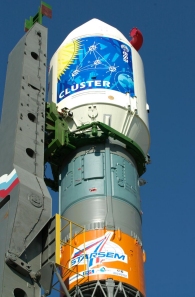 |
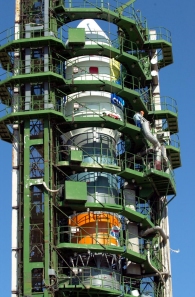 |
Tuesday 11 July
Final assembly Soyuz - upper composite
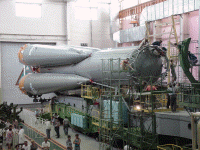 |
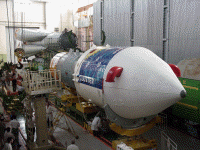 |
The mated Block I and UC have been lifted onto the giant hydraulic erector, to enable their integration with the Soyuz launcher's 1st and 2nd stages. The Block I / UC has been in place just millimetres next to the stage 1 - 2 composite using the overhead crane of the facility, a rather high precision activity for such a huge crane.
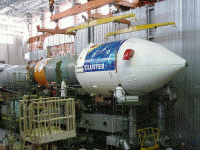 |
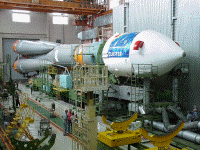 |
The two components were then integrated by 6 bolts. During the flight, these will be cut by a pyrotechnic device to enable separation of Block I from the second stage of the launch vehicle.
After completion of this operation by the Russian engineers, the ESA/Dornier team opened two access hatches in the fairing. The safe plugs on the skin-connector bracket of both spacecraft had to be replaced by the so called arm plugs: Both spacecraft are now armed and ready for flight; all their pyros as well as the high voltage experiments are electrically fully connected!
The launch vehicle is now fully assembled in the Launch Vehicle Integration Hall, ready for roll-out to the pad.
Monday 10 July
Installation onto erector
Electrical connections between Block I and the UC have been performed. Line checks (continuity) of the electrical links has been validated. The pre-assembled main part of the launch vehicle- the 1st and 2nd stages, consisting of a core body (2nd stage) and 4 strap-on boosters (1st stage)- has been moved onto the giant erector, where it awaits its mating with Block I and the UC.
Sunday 9 July
Upper-composite-Block I Mating
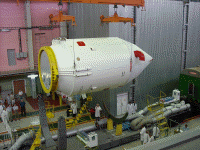 |
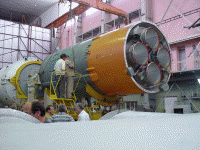 |
The upper composite (UC), consisting of Cluster satellites FM 6 & 7, the flight adapter, the Fregat upper stage, the interstage and the fairing, have been mated mechanically with Block I - the third stage of the Soyuz launcher. Block I stands for injection into an orbital trajectory, as opposed to the ballistic trajectory reached by propulsion stages 1 and 2 of the launch vehicle.
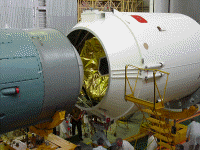 |
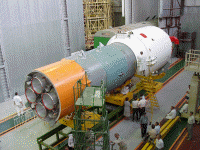 |
To perform this activity, both the UC and Block I have been moved onto mobile integration stands by the huge overhead crane in the launcher integration facility (MIK-40). Using these integration stands, the two components were moved within millimetres of each other, and were then bolted together around the circumference of their interface.
Saturday 8 July
No special activities in addition to the previous day.
Friday 7 July
Rehearsal of the launcher countdown. No F6/F7 activities.
Installation of balance masses on F5/F8 and battery conditioning continued.

